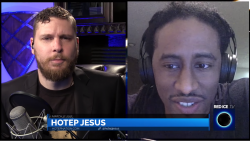Ian Miles Cheong, a longtime writer published in such conservative publications as The Daily Caller and Heat Street, called Canadian law enforcement on Andy “Warski” Pires after a business deal between them soured and Cheong felt the wrath of an online community bent on humiliating and annihilating its subjects.
Right Wing Watch first took note of Pires when he teamed up with Jean-François Gariépy to host “Internet Bloodsports”—a live YouTube program centered on politics that became a hotbed of unabashed white nationalism last year and often ranked, during the airing of one its programs, as one of the top livestreams on YouTube. Months after we first reported on Bloodsports, Gariépy and Pires parted ways over disagreements about the content that they were hosting on a nightly basis, which Pires described as “white-power hour.” Although Pires told us he split with Gariépy over concerns about the prominent white nationalists appearing on the show, as recently as November, he hosted a Nazi-sympathizer on his YouTube channel. After Bloodsports dissolved, Pires appeared to have a mental crisis and even burned his own nipples during a livestream while his guests screamed racial slurs at each other.
Cheong says he has known Pires since 2016 but first began speaking with him at length in August on Discord, a chat platform popularized by video game players, telling Right Wing Watch that they expressed mutual desires to leave full-time political commentary. Pires also told us he’s seeking to become “less political.” Cheong had recently departed Milo Yiannopoulous’ site “Dangerous,” where he contributed to a section sarcastically dubbed “Incel Corner.” (“Incel” is short for “involuntarily celibate.”) Pires and Cheong became friends, sharing intimate details about their offline personal lives with each other.
The duo cooked up an idea for a non-political channel focused on gaming commentary that they decided to call “Hype Break.” As Cheong described it, the duo wanted to create “mainstream” content. While Cheong got to work building out the channel’s first videos, Pires launched a new livestream series he called “Warpath” on his main channel, which he says he sought to use to “expose” other YouTube personalities. Pires also claims that he used the money he generated on the show to pay Cheong for his work on Hype Break.
Through this new show and appearances on other programs, Pires quickly re-entered the community in which Bloodsports thrived and where he had developed close friendships and alliances. Although the community rarely uses the term “Internet Bloodsports” to describe its activities anymore, the design is basically still the same: Stir up extreme amounts of drama online to attract audiences and revenue.
One of Pires’ primary targets was Michael Pilkington, a wrestler who broadcasted on YouTube under the moniker “Tonkasaw,” and once hosted a morning talk show called “Morning Kumite” that was popular with the Internet Bloodsports community. Last year, Pilkington received a community guideline strike on his YouTube channel that prevented him from livestreaming. Pires said that he offered to host Morning Kumite on his own channel, but eventually dropped the show, citing difficulties working with Pilkington. After the cancellation, Pires alleges that Pilkington falsely framed him as a pedophile. Pires said he “stayed up for days drinking Monster energy drinks” after Pilkington’s claims.
The pair continued their public feud, during which Pires said Pilkington would occasionally mention personal information about Pires’ life that he did not share publicly. Arguments escalated, and the men eventually agreed to a cage fight in Knoxville, Tennessee. Despite scheduling a venue, rigging a pay-per-view broadcast, and printing shirts that read “Knoxville Knockout Krew,” a physical fight never took place.
After Pires’ trip to Knoxville, Cheong reached out to Pires offering to buy the Hype Break channel. The duo came to an agreement, or so Cheong says he had thought. Pires denies that he made such a verbal agreement.
Two days after Pires and Cheong supposedly agreed to transfer Hype Break to Cheong’s sole ownership, Pires was shown messages linking Cheong and Pilkington’s girlfriend— someone whom Cheong says Pires already knew that he was longtime friends with—and became convinced that Cheong was part of a “cabal” against him. Pires denies that he was aware of the extent of Cheong’s communications with Pilkington’s girlfriend. He published a video about Cheong that contained personal details about his life and promised more content was to come.
In retaliation, Cheong logged in to Pires’ YouTube account and replaced video thumbnails on Pires’ main YouTube channel with pornographic images, which is against community guidelines on YouTube.
“That was an act of stupidity on my part. I fully admit that,” Cheong said, adding that he thought that if he could earn a community guidelines strike on Pires’ channel, it would prevent Pires from streaming more information about him. Some complaints made against a YouTube channel for violation of the platform’s community guidelines can disable the channel’s ability to livestream.
But Pires’ channel didn’t receive a strike for the porno thumbnails, so Pires continued to post the rest of his video series about Cheong’s suspected skullduggery. That’s when Cheong called Canadian law enforcement against Pires, alleging criminal activity by his former business partner. Audio of Cheong telling someone about his call to Canadian police leaked.
Cheong admitted to Right Wing Watch that he called a Canadian law enforcement tip-line after Pires posted videos to YouTube about him, telling authorities that his former colleague possessed illegal firearms and narcotics, and said he cautioned police that Pires was subject to intense paranoia. He says these were things Pires had told him privately. Detectives arrived at Pires’ home where they spoke with him, found no illegal weapons or drugs, and left.
“My mindset at the time was not very good. He was going after my personal life. I could not get him to stop. YouTube would not respond,” Cheong said. “It’s something I regret, for sure.” In the United States, concocted complaints of that nature often lead to a SWAT team descending on the target’s home, but Cheong seemed to suggest that what he did was less threatening to Pires than it would have been had he lived in the U.S. “I knew I wouldn’t get him killed,” Cheong told Right Wing Watch. “There was no malice there, but I just wanted to get him to stop.”
In the U.S., calls similar to the one Cheong placed to Canadian authorities have resulted in what is known as “swatting”; the dangerous action of having a SWAT police team sent to someone’s home under false pretenses by calling the police to falsely report that a hostage situation or a bomb threat is taking place at the intended victim’s home address. In the past, such pranks have resulted in the targets being killed by police.
Pires was understandably incensed.
“I get angry online. I’m known for getting angry online. I’m hot-headed. But I don’t have bouts of schizophrenia and I am not prone to violence,” Pires told Right Wing Watch.
(This piece was updated at 5:20 p.m.)









